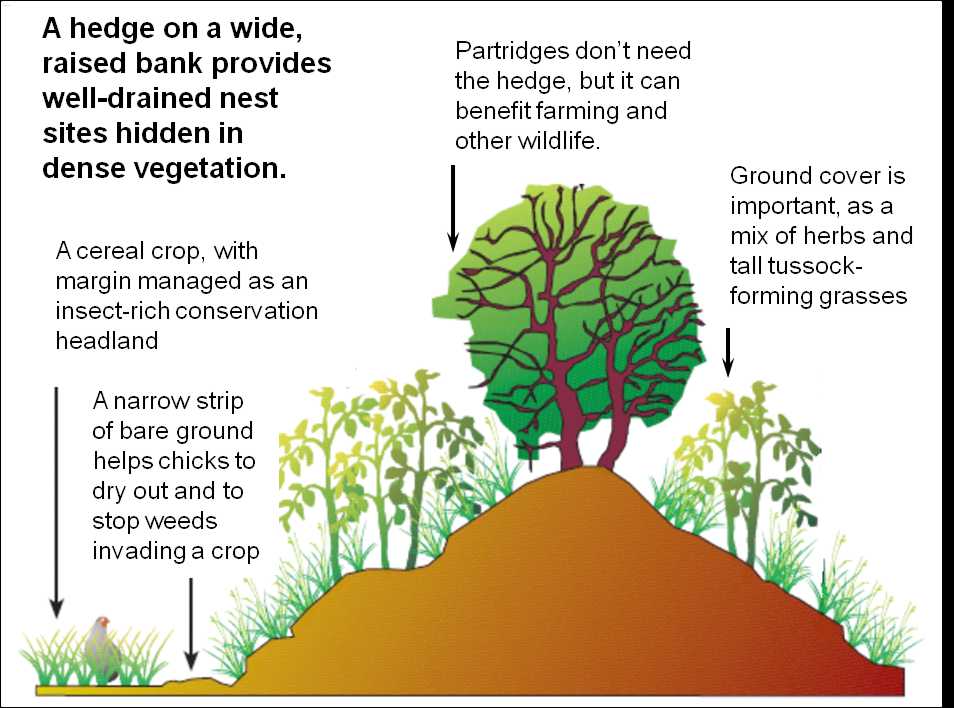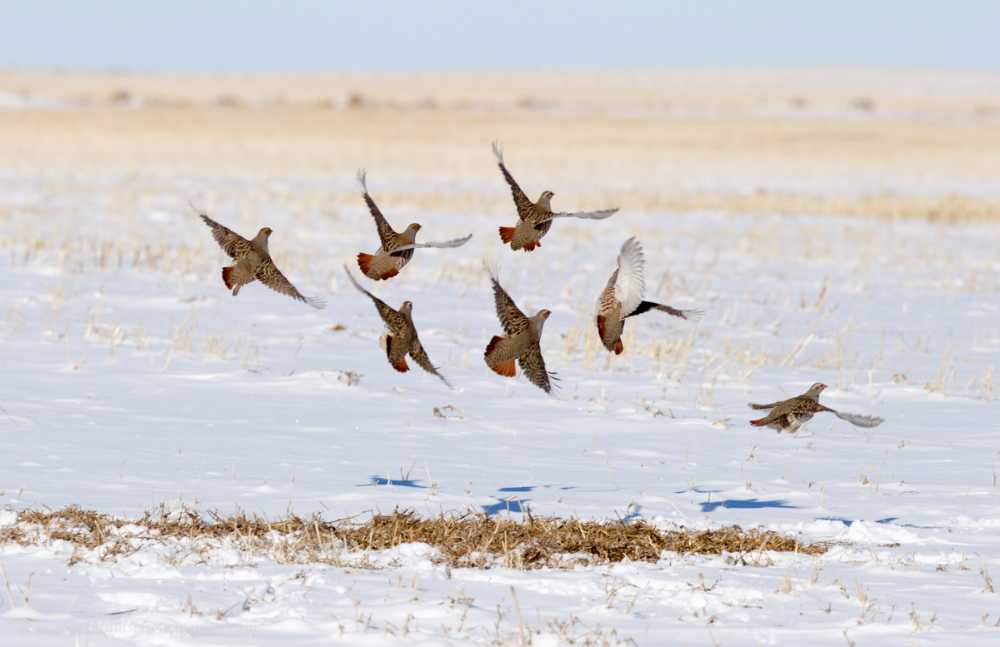Partridges lay clutches of 10-20 eggs. With good supplies of natural food, including plant seeds year round and insects when young are growing fast, their populations can increase quickly. However, as a species that can be abundant, is ground nesting and has a body that is best described as plump and round, they are also attractive as food for many predators. They therefore thrive best in areas with good ground cover from mammals while they lay and incubate their many eggs, and with few trees as perches for buzzards, hawks and corvids (see Menu link for Predation). Where farming leaves few cereal seeds after harvest, other suitable food crops (or artificial feeding) become important. A good diversity of wild plants is highly desirable, to provide seeds throughout the year and to support insects to feed chicks for partridges and other species of farmland bird.
Grey Partridge habitat requirements vary through the year reflecting their life history. Basically, need for food, cover from predators and protection from weather differs during nesting, brood rearing and after summer harvest. Suitable habitat is needed at each stage. Loss and degradation of habitats for each stage vary from country to country and area to area. Scope for restoring a good variety of wild plants also varies for private and public land used for farming, field-side gardens, parks or other amenities, and road verges.
Nesting and brood-rearing habitats

The profile of a field boundary with habitat for partridge nests (© GWCT)
Partridges are at nests for 5-6 weeks while laying and incubating their large clutches. This creates a premium on cover that hinders detection by mammals and raptors (which may kill the female) as well as corvids (which eat eggs), and on good drainage in case of rain. The diagram depicts a raised bank with a hedge between fields. Tall grass tussocks and dense vegetation give cover for nests. In the absence of vegetated boundaries of fields, “beetle-bank” strips of tussocky grass in fields help maintain insects that eat crop pests as well as providing nest sites.
For partridge broods, habitats close to the good nesting habitat need to offer cover from predators as well as food. Tall-standing crops providing good protection from raptors. However, as well as their year-round diet of seeds, partridges need insects, especially plant bugs but also sawfly larvae, for growing chicks. Suitable insects grow on a diversity of plants, which are found in crops and field margins provided a conservation headland of 6-24 m remains free of herbicides and insecticides in summer. Fungicides can be used, and selective herbicides to remove the worst weeds in autumn. If there is no alternative to using a biocide in summer, the spray should be turned off for the outer 12 m of the field.
Studies have shown that 3-7% of suitable vegetation can suffice for partridge breeding in arable land. As linear features are most easily searched by predators, an economic alternative to narrow field margins can be the planting of wider flower-strips for bio-gas production. To support late partridge broods, these and any other bank should not be mowed until after mid-August. Flower strips and beetle banks are best not mowed entirely each year, in order to encourage cover and seeding from biennial plants. In order to hinder predation in these strips and banks, ensure they are not connected to field margins.
After cereal harvest

Partridges lift from a stubble in winter (© M Williams)
On modern farmland, there is a premium on food supplies in the winter. Fields tend to be very bare, so cover from predators is important too. It is helpful to leave stubbles for as long as possible after harvest. Stubbles can be improved by undersowing with plants that provide nitrogen for the soil, food for partridges (both plant and insect) and cover through winter. Planting strips of quinoa (or millet) and kale provide both food, and cover even after light snow-falls, ideally in sites as far from woodland as possible. In uncultivated areas, natural seed-rich species such as Chenopodium (aptly named Fat-hen in English) can be encouraged. Feeders too may be used, ideally well-protected from mammals that may steal seed and with other barriers to hinder raptor attacks. Visit the national sites linked below for suitable feeder designs and more on habitats in your country.
How partridge habitats affect other species
Habitat that is good for partridges has implications for other species. Avoiding as much use of herbicides and insecticides as possible benefits plants that give enjoyment to people and insects (food for many other animals as well as providing pollination resources). As well as the beauty of butterflies and bumblebees, insects and wild plant seeds that feed partridges support other birds that have become rare on farmland. Banks for partridges and flower-strips are habitat for insects that eat crop pests. Banks may carry hedges, too, which provide farmland wind-breaks, nest cover for other birds and food for them in winter. However, hedges should not be high, or have more than 10 trees per kilometre of field boundary, as perches for raptors and corvids. Other rare species can gain from management to reduce predation on partridges.
On the web
Your national Perdix site describes opportunities for managing habitats for Grey Partridge and other species in your country.